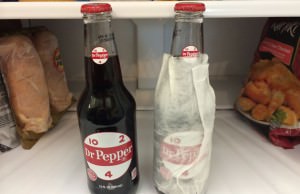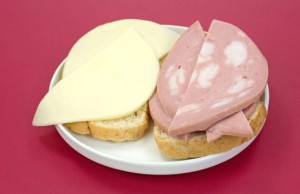21 Worst Foods For Diabetes

Although living with diabetes doesn’t mean deprivation, some foods should be avoided because they are high in saturated fat, sodium, calories or carbs.
If you have diabetes, avoid these 21 foods which can cause blood sugar spikes or other health problems. And don’t worry, we listed the alternatives to all your favorite foods!
1. Candy
Although a lot of people believe that diabetics are not allowed to eat sugar and desserts, you can actually eat a small serving of your favorite cake once in a while and still manage your diabetes. However, it is important to note that if you cannot resist a sweet craving, you need to keep your portions small.
Since we clarified this common misconception, we need to warn you that high sugar foods cause a dramatic spike in blood sugar levels and can contribute to weight gain – two factors which can increase your risk of diabetes complications.
It would be best if you could satisfy your sweet tooth by eating high-quality carbohydrates such as apples, berries, pears, grapes, and oranges. Apart from being tasty, they are packed with fiber which helps the absorption of glucose. Basically, it is much easier to control your blood sugar level while snacking on fresh fruits.

2. Frozen Meals
In today’s super busy world, frozen meals might seem like a gift from the heavens above. However, you shouldn’t mistake a convenient meal with a healthy one. Since frozen meals are loaded with sodium and fat, they are definitely not a healthy option for you and your family.
On the brighter side, the frozen food industry has come a long way and many manufacturers offer healthier meals. The American Diabetes Association (ADA) advises you to choose meals that have 500 calories or less per serving, 3 grams of saturated fat or less per serving and 600 mg of sodium or less per serving.
ADA reports that the worst choices are Hungry Man Frozen Meals, Marie Callendar’s Fettucine Alfredo with Chicken and Broccoli and Stouffer’s Cheese Ravioli. On the other hand, there are a lot of healthier choices on the market: Lean Cuisine, Smart Ones, Healthy Choice, and Amy’s Low in Sodium line.

3. Sugary Drinks
It’s best to avoid sugary drinks like regular soda, fruit punch, fruit drinks, energy drinks and sweet tea. Apart from being loaded with calories, these beverages will raise blood glucose. The American Diabetes Association warns diabetics not to consume sugary drinks because they have several hundred calories in just one serving!
‘’One 12-ounce can of regular soda has about 150 calories and 40 grams of carbohydrate. This is the same amount of carbohydrate in 10 teaspoons of sugar! One cup of fruit punch and other sugary fruit drinks have about 100 calories (or more) and 30 grams of carbohydrate.’’
We recommend drinking zero-calorie or very low-calorie drinks such as water, unsweetened tea, coffee and diet sodas. If you get tired of plain water, flavor it with a squeeze of lemon or lime juice.

4. Milk Shakes
We don’t need to tell you that milk shakes are packed with sugar and calories, but you might not have been aware that they can also contain trans fats which are really bad for your heart. According to Diabetic Living Online, a 16-ounce chocolate milk shake at A&W Restaurant has 700 calories, 1 gram of trans fat (with 29 grams of total fat), and 100 grams of carb.
Naturally, if you add whipped cream, the number of calories and sugar are much higher. Also, 16-ounce chocolate shake from Mc Donald’s has 700 calories, 20 grams of fat, 1 gram of trans fat, and 114 grams of carb.
Luckily, there are delicious, healthy substitutes for sugar and calorie-loaded milk shakes. For instance, you can eat whole fresh fruit or nonfat frozen yogurt. And if you really want to sweeten your meal, try small fruit smoothies.

5. Purchased Smoothies
Since we’ve mentioned fruit smoothies, we have to clarify things. Making your own smoothie is an excellent idea, while buying one in a fast-food restaurant is not such a good choice. Although purchased smoothies look fresh and healthy, they are actually packed with hidden sugar. And the portions are always extra-large.
For example, a 16-ounce Strawberry Whirl Jamba Juice Smoothie serving has 46 grams of sugar, 220 calories, and 54 grams of carb. McDonald’s McCafe Strawberry Banana Real Fruit Smoothie comes in three sizes. The smallest, 12 ounces, contains 210 calories, 44 grams of sugar, and 44 grams of carb, while the largest, 22 ounces, has 70 grams of sugar and 74 grams of carb.
Home-made, fresh fruit smoothies are by far the best and healthiest option. Plus, you can use your imagination and make a smoothie that’s just perfect for you.

6. Fast-Food Hamburgers
According to EverydayHealth, research shows that African-American women who eat hamburgers in a fast-food diner two or more times a week are much more likely to receive a diabetes diagnosis than those who do not. To sum it up, hamburgers are high in saturated fat which is the leading factor in high cholesterol levels. However, you’re not supposed to cut out saturated fat completely since the American Heart Association recommends limiting it to seven percent of your total calorie intake.
For example, Burger King’s hamburger contains 240 calories, 9 g total fat, 3.5 g saturated fat, 490 mg sodium, 28 g carbohydrate and 30 mg cholesterol, while Mc Donald’s hamburger has 250 calories, 9 g total fat, 3.5 g saturated fat, 480 mg sodium, 31 g carbohydrate and 25 mg cholesterol.
Before heading to a restaurant, make sure to check their website for nutrition information. If it isn’t available, ask the staff at the diner about lighter menu options.

7. Fast-Food French Fries
Few people know just how many calories even a small serving of French fries contains. However, they are loaded with saturated fat, sodium, and calories. According to Diabetic Living Online, even trans-fat-free fries aren’t healthy for you. For instance, a large portion of French fries from Burger King has 500 calories, 22 g total fat, 3.5 g saturated fat, 710 mg sodium and 72 g carbohydrate. The same serving from Mc Donald’s contains 500 calories, 25 g total fat, 3.5 g saturated fat, 350 mg sodium and 63 g carbohydrate.
Also, a small, 85-gram serving of fast-food French fries contains 33 grams of carbohydrates, including 3 grams of fiber, according to Healthy Eating:
‘’When counting carbs, fiber is often subtracted from the total carb count since it isn’t digested, leaving 30 grams of carbs for this serving. One carb serving for a diabetic is 15 grams of carbohydrate, so each small serving of French fries counts as two carbohydrate servings.’’
As an alternative, make sweet potatoes which are packed with vitamin A and potassium.

8. White Rice
Like all processed foods made with refined flour, white rice raises your blood sugar and has a lot of preservatives. Basically, all foods containing carbohydrates can affect your diabetes. Here are some numbers:
A cup of white rice contains around 53 grams of carbohydrates, while a slice of bread has around 15 grams of carbohydrates, which means that a cup of white rice is the equivalent of three and a half slices of bread. Brown rice has 46 grams per serving, or the equivalent of three slices of bread.
Also, white rice has a glycemic index between 72 and 83, while the glycemic index of brown rice varies between 48 and 62. If you can’t live without white rice, try white basmati and Moolgiri rice which have a glycemic index rating of 53 to 54.

9. Battered Fish Dinners
A platter with two deep-fried fish fillets, hush puppies, fries, and slaw has more than 1,300 calories, 84 grams of fat, 113 grams of carb, and 3,000 milligrams of sodium. Even though the average American takes in about 3,400 mg of sodium per day, the American Diabetes Association recommends that people with diabetes consume up to 2300 mg or less per day.
‘’Decreasing the amount of sodium in the diet can help many people lower their blood pressure. Lowering blood pressure also means you are decreasing your risk for heart attack or stroke, both of which are common diabetes complications.’’
According to Diabetic Living Online, a Long John Silver’s meal (2 pieces battered pollock, 2 hush puppies, fries, coleslaw, and tartar sauce) contains 1,323 calories, 84 g total fat, 19 g saturated fat, 3,005 mg sodium, 113 g carbohydrate and 100 mg cholesterol. Naturally, you don’t have to cut out fish, just prepare it in a different way.

10. Bacon
According to a study from Harvard University, eating too much processed meat such as bacon, sausage and processed deli meats could increase your risk of heart disease and type 2 diabetes.
“The most important finding is that eating daily 50 grams of processed meats is associated with 42 percent higher risk of heart attacks and 19 percent higher risk of diabetes, while unprocessed red meat was not associated with risk.”
No, red meat is still not good for you because it contains saturated fats and cholesterol. The main difference between red meat and processed meat is that the latter also contains high levels of salt and preservatives, such as nitrates.
And since people with diabetes are already at an increased risk of heart disease, eating these meats puts them at an even greater risk of developing cardiovascular diseases.So, instead of bacon, fill your plate with lean protein choices like skinless chicken and turkey, fish and shellfish.

11. High-Fructose Corn Syrup
A lot of packaged foods contain high-fructose corn syrup, including sweet pickle relish, ketchup, jams and jellies, and salad dressings.
Researchers from the University of Oxford and the University of Southern California found that countries using high-fructose corn syrup had rates of diabetes that were about 20% higher than countries that didn’t mix it into foods.
Co-author Stanley Ulijaszek, Director of the Institute of Social and Cultural Anthropology at the University of Oxford, said in a statement that their analysis shows that high fructose corn syrup can increase the risk of type 2 diabetes.
“Many people regard fructose as a healthy natural sugar from fruit, and that’s true. Natural fructose found in fruit for example, is fine. But there is evidence that the body struggles to metabolize large amounts of fructose that does not come from fruit, and there is a risk for type 2 diabetes because fructose and sucrose are not metabolically equivalent.’’

12. Raisins
Although the carbohydrates found in raisins are healthier than those in white breads, cakes and soft drinks, all carbohydrates can raise your blood sugar levels – if you eat a lot of them. Raisins are packed with fiber, vitamins and antioxidants, but that doesn’t mean you shouldn’t pay attention to the amount of them you eat since consuming too many raisings at once may cause your blood sugar levels to spike.
A 1.5-ounce box of sugar-free raisins has 34 grams of carbohydrates, which is the equivalent of carbohydrates found in two slices of bread. Of course, you should avoid raisins that contain added sugar because unsweetened raisins already contain natural sugars.
Instead of raisins, opt for grapes because they have enough water to dilute their natural sugars. It would be best to limit yourself to about 1/2 cup of fresh grapes per day.

13. Sugary Cereals
A very popular breakfast food, sugary cereals are processed foods which have a lot of sugar. Additionally, they lack dietary fiber – and a high-fiber diet is a must for diabetics. Even though it is a type of carbohydrate, fiber is not broken down by the human body and does not contain any calories.
A study in the New England Journal of Medicine showed that people with diabetes who ate 50 grams of fiber a day managed to control their blood glucose better than those individuals who ate far less. You can add fiber in your diet if you eat whole grain products, fruits, vegetables, and legumes. Also, leave the skin on fruits and vegetables, as it is high in fiber.
When it comes to cereals, buy those that provide at least 5 grams of fiber per serving and don’t contain large amounts of sugar.

14. Canned Fruit in Heavy Syrup
Although eating fruits is good for people with type 2 diabetes, diabetics should definitely avoid canned fruits in heavy syrup because it has added sugar than can raise glucose levels.According to the American Diabetes Association, the best kinds of fruit are fresh, frozen or canned without added sugars.
So, if you want canned fruits, buy the ones that are packed in their own juice or in water. Although you can somewhat lighten the sugar load by rinsing the syrup off fruit packed in heavy syrup, canned fruit usually absorbs the sugar from the syrup so rinsing the fruit might be pointless.
When purchasing canned fruits, remember that a 1/2 cup of canned fruit without added sugar has about 15 g of carbohydrates, which is the same as the amount of carbohydrates in a small piece of whole fresh fruit.

15. Processed Lunch Meat
Many people assume that making a sandwich for lunch is a good option. We hate to break it to you, but processed lunch meat is packed with sodium and too much salt is bad for everyone, let alone diabetics.
When you purchase meat in the store, read the nutrition labels or ask a store attendant to tell you the nutrition information for the meat you want to buy. According to Diabetic Living Online, some cold cuts are low in fat, such as Oscar Meyer Deli Fresh Honey Ham but it has a whopping 650 milligrams of sodium in one serving.
It is essential that you take in less sodium, so ask deli attendants for meats lower in sodium or google healthy sandwich recipes designed for people with diabetes.

16. Doughnuts
Sadly, people with diabetes should avoid commercially baked goods such as muffins, pastries, and doughnuts because they are full of calories, sugar and fat. To top it all, some of them contain trans fats. To lower your risk of diabetes complications, you need to eat less saturated and trans fats.
Both of them increase blood cholesterol levels, but trans fats are worse for diabetics and you should eat as little of them as possible. Trans fats are listed on labels so you need to read the ingredient lists on foods. Other sources of trans fats include snacks such as crackers and chips, stick margarines and some fast food items.
According to Diabetic Living Online, one doughnut from Dunkin’ Donuts has 360 calories, 22 grams of fat, 10 grams of saturated fat, 44 grams of carb, and 19 grams of sugar.

17. Pizza
One of the most popular foods in the world, pizza also ranks high among favorite foods in the United States. The darling of every party, commercially made pizzas are bad for your health. Luckily, pizza is a simple dish which can be made at home, where you can control all the ingredients, including the bad ones.
Apart from being loaded with calories, pizza is high in sodium, carbs and fat. An average slice of pizza contains a minimum of 300 calories, 700 mg of sodium and 5 g of saturated fat.
According to the American Diabetes Association, people with diabetes should eat less than 10% of calories from saturated fat, which equals to about 20 g per day. So, if you can’t live without pizza, prepare it at home – in addition to controlling the sodium, fat, carbs and calories, you can experiment with the ingredients and have a good time.

18. Chicken Skin
Apart from being high in saturated fat, chicken skin will also increase your cholesterol levels. Unfortunately, cholesterol from the food you eat may increase your blood cholesterol so the American Diabetes Association advises you to take in less than 300 mg per day. Since food manufacturers have to list cholesterol on food labels, it’s a good idea to read nutrition information on the food packaging.
Other sources of cholesterol include high-fat dairy products (whole or 2% milk, cream, ice cream, full-fat cheese), egg yolks, liver and other organ meats and high-fat meats. You should also steer clear of fried chicken because it has a lot of carbs, calories, sodium, and fat. Instead, always choose grilled chicken which is much healthier than the fried version.
Diabetic Living Online reports that KFC’s Extra Crispy Fried Chicken contains 490 calories, 29 g total fat, 4.5 g saturated fat, 1,140 mg sodium, 20 g carbohydrate and 110 mg cholesterol, while KFC’s Grilled Chicken has 220 calories, 7 g total fat, 2 g saturated fat, 730 mg sodium, 0 g carbohydrate and 135 mg cholesterol.

19. Whole Eggs
Eating five or more whole eggs per week is associated with an increased risk of developing type 2 diabetes. In addition, diabetics who consumed more than one egg per day doubled their cardiovascular diseases or death risk compared to diabetics who ate less than one egg per week, according to several studies.
Since only the yolk contains cholesterol and fat, you can eat all the egg white your heart desires. In fact, if you only eat egg whites, you are still getting about the same amount of protein without the fat and cholesterol. Further, you are also consuming less calories.
To replace one whole egg, use two whites. You can also use egg substitutes which are made using egg whites only. Usually, about ¼ cup of egg substitute is used instead of one whole egg.

20. Ketchup
Although most people think that ketchup is a salty condiment, it actually contains a lot of sugar. We’ve talked about processed foods which are made with high fructose corn syrup and ketchup is unfortunately one of them. And it’s not just ketchup. Many other condiments, including sweet pickle relish, BBQ sauces, steak sauces, and salad dressings, are packed with HFCS.
This product is dangerous for a number of reasons. In addition to being high in calories, HFCS causes a huge blood sugar spike, and afterwards a rapid drop. But HFCS is not the only ingredient in ketchup that is bad for people with diabetes.
Commercially made ketchup is also high in sodium which contributes to high blood pressure and damages arterial walls. It would be best to completely avoid ketchup and other condiments, and switch to healthier alternatives such as mustards, herbs, spices, flavored vinegars, low-sodium soy sauce, chopped onions, and garlic.
21. Energy Bars
Although energy bars may seem like a dream come true, some of them are no different than regular candy bars. For instance, a single energy bar can have a glycemic load over 49, which is considered extremely high (even 20 is high!).
Since not all bars are created equally, it is important to read labels carefully and chose energy bars made with nuts, whole grains, and just a few added natural sweeteners. Experts agree that these bars are convenient, but stress that some of them are just too high in sugar and saturated fat to be regarded as healthy snacks.
Even though energy bars are handy, opt for alternative snacks such as whole-grain crackers, grapes and cottage cheese, apples and cheese or veggies with low-fat yogurt. Stock up on healthy snack options so you always have them on hand, but avoid eating when you are bored or sitting in front of the TV.









